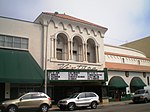Ventura Pier

The Ventura Pier, formerly known as the Ventura Wharf and the San Buenaventura Wharf, is a wooden pier located on the Pacific Ocean in Ventura, California. The pier has been designated as Ventura Historic Landmark No. 20. It is the oldest pier in California. The pier was first built in 1872 and served for many years as a transportation hub and commercial wharf used to bring merchandise and lumber to the area and to export the area's agricultural products and crude oil. It is no longer used as a commercial wharf and is instead used for fishing and as a pedestrian walkway with views of Ventura and the Channel Islands. It has been partially destroyed by storms and waves on several occasions and by collision with the steamer Coos Bay in 1914. From 1938 to 1995, it was the largest wooden pier on the California coast at a length of 1,958 feet (597 meters). In its current configuration, the pier is 1,600 feet (490 meters) long.
Excerpt from the Wikipedia article Ventura Pier (License: CC BY-SA 3.0, Authors, Images).Ventura Pier
Omer Rains Coastal Bike Trail, Ventura
Geographical coordinates (GPS) Address Nearby Places Show on map
Geographical coordinates (GPS)
| Latitude | Longitude |
|---|---|
| N 34.2741 ° | E -119.2915 ° |
Address
Ventura Pier
Omer Rains Coastal Bike Trail
93001 Ventura
California, United States
Open on Google Maps










